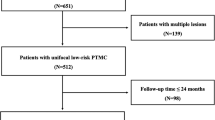Abstract
Although fine-needle aspiration biopsy (FNAB) is a useful tool for diagnosing thyroid carcinoma, there are some risks of complications. In this study, we investigated tumor implantation by FNAB of papillary carcinoma. We compared the characteristics of the main tumors and implanted tumors of patients showing FNAB implantations. Between 1990 and 2002, 4912 patients underwent FNAB and were diagnosed as having papillary carcinoma. We encountered 7 cases of needle tract implantation, which account only for 0.14%. We reviewed these 7 cases as well as 3 other patients who underwent FNAB in other hospitals. The intervals between FNAB and detection of the implanted tumor ranged from 2 to 131 months. For these 10 patients, the main tumors in 6 were diagnosed as poorly differentiated carcinoma, and 7 showed extrathyroid extension. Five showed the development of implanted tumor after comparatively shorter intervals (2–68 months), and we classified these as the short interval group. The remaining 5 were classified as the long interval group, because tumor development occurred after 87–131 months. All 5 cases in the short interval group involved preoperatively detectable lymph node metastasis; those in the long interval group did not. The MIB-1 labeling index of the implanted tumor was high in 4 cases in the short interval group, but it was low in all cases in the long interval group. The implanted tumors could be surgically removed without recurrence at the focal sites. These findings indicate that, although high growth activity in the metastatic lesions may be a risk factor of FNAB, inducing the growth of implanted tumors along the needle tract within a short interval after the procedure, FNAB remains the most useful technique for diagnosing thyroid carcinoma. The incidence of implantation was low, and when it did occur, the tumors could be surgically removed without recurrence.
Similar content being viewed by others
References
Ito Y, Uruno R, Nakano K, et al. An observation trial without surgical treatment in patients with papillary microcarcinoma of the thyroid. Thyroid 2003;13:381–388
Evans GH, Harries SA, Hobbs KE. Safety and necessity for needle biopsy of liver tumors. Lancet 1987;1:620
Sakurai M, Okamura J, Seki K, et al. Needle tract implantation of hepatocellular carcinoma after percutaneous liver biopsy. Am J Surg Pathol 1983;7:191–195
Smith FP, MacDonald JS, Schein PS, et al. Cutaneous seeding of pancreatic cancer by skinney-needle aspiration biopsy. Arch Intern Med 1980;140:855
Kosugi C, Furuse J, Ishii H, et al. Needle tract implantation of hepatocellular carcinoma and pancreatic carcinoma after ultrasound-guided percutaneous puncture: clinical and pathologic characteristics and the treatment of needle tract implantation. World J Surg 2004;28:29–32
Ito Y, Uruno R, Nakano K, et al. An observation trial without surgical treatment in patients with papillary microcarcinoma of the thyroid. Thyroid 2003;13:381–388
Ito Y, Uruno T, Takamura Y, et al. Papillary microcarcinoma of the thyroid with preoperatively detectable lymph node metastasis show significantly higher aggressive characteristics on immunohistochemical examination. Oncology 2005;68:87–96
Ito Y, Yoshida H, Tomoda C, et al. Maspin expression is directly associated with biological aggressiveness of thyroid carcinoma. Thyroid 2004;14:13–18
Sakamoto A, Kasai N, Sugano H. Poorly differentiated carcinoma of the thyroid. A clinicopathological entity for a high-risk group of papillary and follicular carcinomas. Cancer 1983;52:1849–1855
Schindler AM, van Melle G, Evequoz B, et al. Prognostic factors in papillary carcinoma of the thyroid. Cancer 1991;68:324–330
Bellantone R, Lombardi CP, Boscherini M, et al. Prognositc factors in differentiated thyroid carcinoma: a multivariate analysis of 234 consecutive patients. J Surg Oncol 1998;68:237–241
Ito Y, Tomoda C, Uruno T, et al. Ultrasound-detectable and anatomopathologically detectable node metastasis in the lateral compartment as indicators of worse relapse-free survival in patients with papillary thyroid carcinoma. World J Surg 2005;29:917–920
Author information
Authors and Affiliations
Corresponding author
Rights and permissions
About this article
Cite this article
Ito, Y., Tomoda, C., Uruno, T. et al. Needle Tract Implantation of Papillary Thyroid Carcinoma after Fine-needle Aspiration Biopsy. World J. Surg. 29, 1544–1549 (2005). https://doi.org/10.1007/s00268-005-0086-x
Published:
Issue Date:
DOI: https://doi.org/10.1007/s00268-005-0086-x




